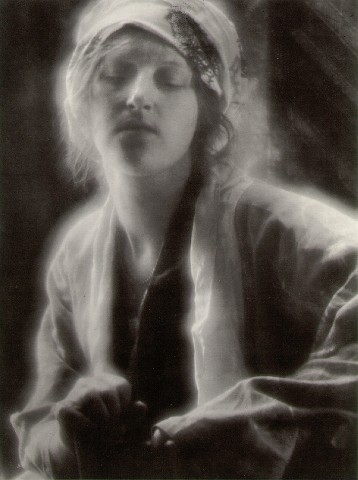Imogen Cunningham was an American photographer born April 12, 1883. Her parents named her “Imogen” after the character in Cymbeline, a play by Shakespeare. She was born in Portland, Oregon, and was interested in art from a very early age. The schools there didn’t teach art, but her parents sent her to art lessons and classes on weekends and during school vacations.
When she was 16, she bought her first camera by mail order. It was a typical camera for the time; a 4”x5” view camera, and by modern standards, a complicated nightmare to use. To be a photographer in those days you had to do practically everything yourself, including preparing the glass plates to capture the images. Probably because of that, Cunningham studied chemistry at the University of Washington — specifically, the chemistry underlying photography. At the same time, she earned tuition money by photographing plants for the school’s botany department.
After graduating, Cunningham got a job at a photography studio, where she learned platinum printing. She also helped the head of the studio, Edward Curtis, on his huge project documenting Native American tribes — it became a 20-volume set of books published between 1907 and 1930. Then in 1909 she received a fellowship and traveled to Germany to continue studying photographic chemistry. At the time her main interest wasn’t actually taking photos, but in the processes involved in producing photos and prints. She identified alternatives to platinum for photo printing, saving the photo department at the Technical University of Dresden lots of money, since platinum was so expensive.
When she went back to Seattle she started to concentrate on taking photos again, and opened her own studio. She married Roi Partridge, an artist and print maker, and he became a frequent subject in her photos. She caused a bit of a scandal when she exhibited some nude photos of him, but Cunningham ignored the controversy. By 1913 her work was widely known and she’d had exhibitions in New York. Her reputation continued to grow, as did her personal life; by 1920 she’d had three children and the family had moved to Oakland, California, where her husband taught art at Mills College.
Photography at the time often used soft focus, and starting in the 1920s Cunningham and some colleagues formed an organization they called Group f/64 to promote sharp-focus, “straight” photography. The name of the group was taken from the smallest aperture used in cameras — the smaller the aperture, the sharper the image. Cunningham said at the time “This does not mean that we all used the small aperture, but we were for reality. That was what we talked about too. Not being phony, you know.”
During the 1930s Cunningham did a lot of work for Vanity Fair magazine, taking portraits of actors, writers, artists, and other prominent people from the arts. Then in the 1940s she switched to street photography — partly because the cameras and film becoming available were far more portable and convenient. She also began teaching, after being invited to join the faculty at the California School of Fine Arts.
Cunningham lived to be 93, and continued taking photos her whole life. Her work influenced generations of photographers and maybe the whole course of art photography in the 20th Century — you can see her prints at https://www.imogencunningham.com/
This is a photo by Cunningham around 1910

Dream By Imogen Cunningham – Wilson’s Photographic Magazine, Volume 51, 1914 The Photographic journal of America, 1920, Public Domain, https://commons.wikimedia.org/w/index.php?curid=924811
This is an example of her work from 1962

Quail Eggs by Imogen Cunningham, 1962
